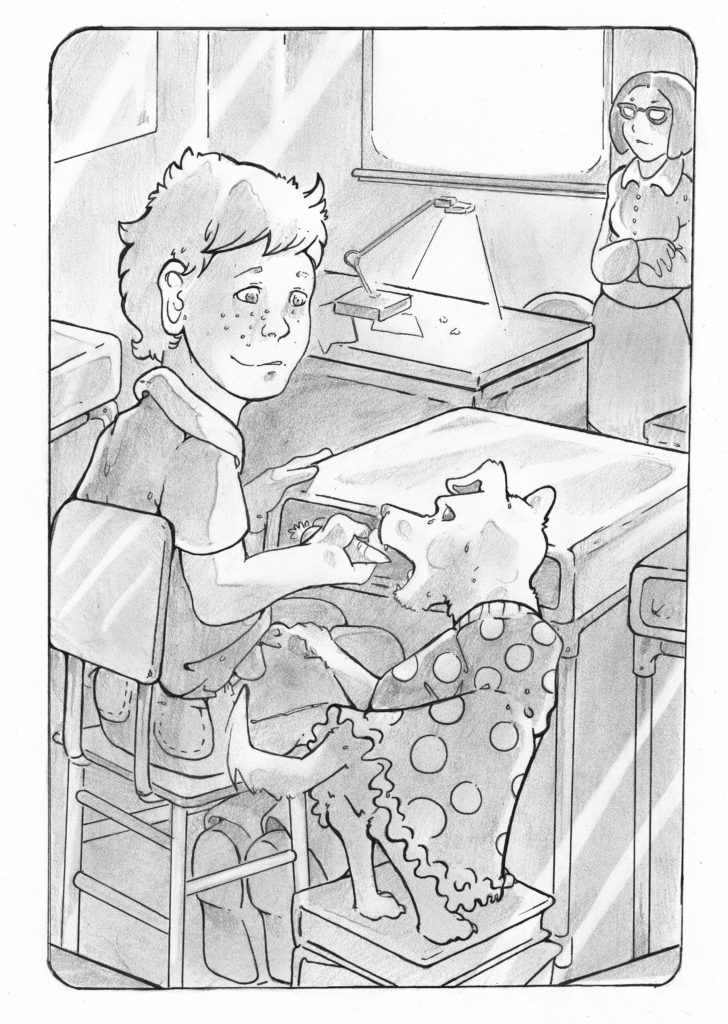“Every class needs a mascot, and it seemed Ms. Kibblesworth’s kids had found theirs”.

For a year and a half after writing Buddy’s story, my main task for the book was to communicate back and forth with Meghan, the illustrator, to check on how the pictures were coming along. I sent Meghan the entire text, along with some guidelines, such as the following for the image above: *Illustration of the classroom with Buddy propped up on a stack of books with Fred feeding him carrots, with Ms. K at the front of the class
Meghan and I collaborated virtually (mostly by email) – and I continued my writing in a mini-blog format on Instagram, using photos I took as writing prompts for observations of the dogs’ funny antics, often imagining conversations between the two dogs. Buddy and Ladybug are (and sadly, was, in Buddy’s case) just a joy to be around, and through the uncertainties of the pandemic, I was more grateful than ever for their loving, goofy presences.
Last winter, while continuing to build an Instagram audience, I spent a good deal of time researching the self-publishing process. I chose self-publishing because I wanted people to read and enjoy the book – and for Buddy’s fictional AND real-life stories to be shared. Although I will continue to submit the book to traditional publishers (you never know what opportunity might be out there), too often, manuscripts sit in an editor’s stack and don’t see the light of day. I felt that Buddy’s joyful story needed to be shared – and that I would like to have some control over the process.
Here are a few of the steps I took to research how to self-publish my book. Through my sister’s business, PHHNIX, I discovered the Australian Writers’ Centre. The AWC offers a short online course on self-publishing books via Amazon. After taking this short course, I decided NOT to go the Amazon-only route. There are a few reasons I chose to go with a well-known self-publishing company, FriesenPress, rather than hiring freelancers and using Amazon by itself:
-To self-publish without a self-publishing company, I’d need to hire at least two freelancers – a cover designer and an interior pages designer – OR buy a publishing platform for my computer and teach myself, which would cost $500+ and also take a lot of time to learn. My very rough calculations told me that hiring freelancers alone would easily cost as much as having a self-publishing company create the book
-The self-publishing company does soft cover, hardcover, and e-books – so all of the design could happen in one place. I had also seen samples of their books and knew that this company had a good reputation, so there was no need to interview or vet designers (which I’d have to do if I was hiring a freelancer or two online).
-FriesenPress also takes care of distribution, which includes Amazon, plus additional platforms – so I surmised I’d get more people looking at/buying my books (I hope this is the case – I’ll let you know once I start selling books!)
-Most importantly, I wanted a professional product that was properly edited and could be sold at local bookstores, and that libraries might consider buying for students. I asked the opinion of a local bookseller, and they said that professional editing is an absolute must, which is another reason I went with a self-publishing company (editing on various levels is part of their packages).
-As an added bonus, the self-publishing company is Canadian and is employee-owned, which I thought was worthwhile.
If you are an indie author, too, what process did you take in self-publishing your book?

Nice website!
Thank you, Barb! I’m glad you like it 🙂